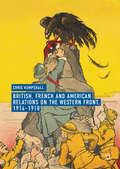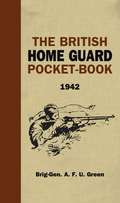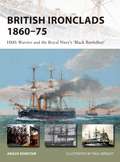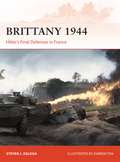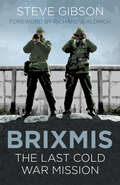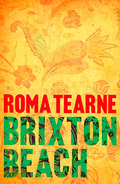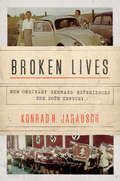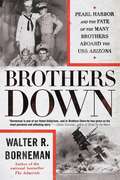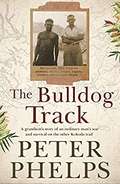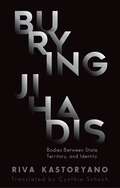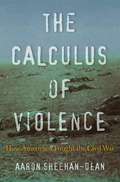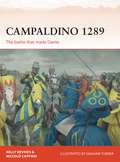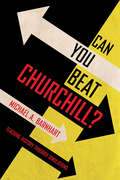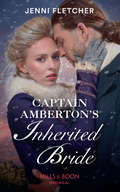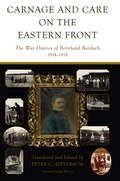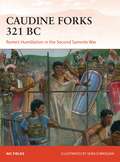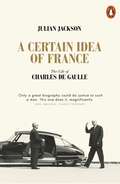- Table View
- List View
British Flag Officers in the French Wars, 1793-1815: Admirals' Lives
by John MorrowDuring the French wars (1793-1801, 1803-1815) the system of promotion to flag rank in the Royal Navy produced a cadre of admirals numbering more than two hundred at its peak. These officers competed vigorously for a limited number of appointments at sea and for the high honours and significant financial rewards open to successful naval commanders. When on active service admirals faced formidable challenges arising from the Navy's critical role in a global conflict, from the extraordinary scope of their responsibilities, and from intense political, public and professional expectations. While a great deal has been written about admirals' roles in naval operations, other aspects of their professional lives have not been explored systematically.British Flag Officers in the French Wars, 1793-1815 considers the professional lives of well-known and more obscure admirals, vice-admirals and rear-admirals. It examines the demands of naval command, flag officers' understanding of their authority and their approach to exercising it, their ambitions and failures, their professional interactions, and their lives afloat and onshore. In exploring these themes, it draws on a wide range of correspondence and other primary source material. By taking a broad thematic approach, this book provides a multi-faceted account of admirals' professional lives that extends beyond the insights that are found in biographical studies of individual flag officers. As such, it will be of great interest to students and scholars of British naval history.
British, French and American Relations on the Western Front, 1914–1918
by Chris KempshallThis book provides a thorough examination of the relations between the men in the British, French and American armies on the Western Front of the First World War. The Allied victory in 1918 was built on the backs of British, French, and American soldiers who joined together to fight for a common cause. Using the diaries, records, and letters of these men, Chris Kempshall shows how these soldiers interacted with each other during four years of war. The British army that arrived in France in 1914 became isolated from their French allies and unable to coordinate with them. By 1916, Britain’s professional soldiers were replaced by civilians who learned to love their French ally, who reached out to them in friendship. At the end of the war the introduction of American soldiers caused hope and conflict before perceived British failures brought the alliance to the brink of collapse. Final cooperation between these three nations saw them victorious.
British, French and American Relations on the Western Front, 1914–1918
by Chris KempshallThis book provides a thorough examination of the relations between the men in the British, French and American armies on the Western Front of the First World War. The Allied victory in 1918 was built on the backs of British, French, and American soldiers who joined together to fight for a common cause. Using the diaries, records, and letters of these men, Chris Kempshall shows how these soldiers interacted with each other during four years of war. The British army that arrived in France in 1914 became isolated from their French allies and unable to coordinate with them. By 1916, Britain’s professional soldiers were replaced by civilians who learned to love their French ally, who reached out to them in friendship. At the end of the war the introduction of American soldiers caused hope and conflict before perceived British failures brought the alliance to the brink of collapse. Final cooperation between these three nations saw them victorious.
The British Home Guard Pocketbook
by A.F.U. GreenThe Home Guards are an attacking force lying in wait for, and ready to destroy, and enemy who dares to set foot on out shores.' The Home Guard has been immortalised in British culture in the TV series Dad's Army. Formed by men not eligible for active service – too old, too young, in reserved occupations vital to the war effort – who were expected to resist a German invasion with any resources they had to hand, the Home Guard is the embodiment of plucky British resolve against the odds. The Home Guard Pocket-Book evokes this spirit. Written by Brig-Gen Green, commanding 4th battalion, Sussex Home Guard and Training Adviser for the Sussex Zone, this book is based on his experience and, in his own words, 'is the result of my ransacking the dusty pigeon-holes of memory and the condensation of many books, official instructions and writings'. Its tone is informal and colloquial, such as: 'March discipline. Troops will always march off the parade ground at the Slope. As soon as this has been done the order "March at Ease" should be given. When marching at ease the rifle may be carried in any way a soldier fancies.' Nevertheless, the book is full of sound advice on training, organisation and discipline, fire arms, reconnaissance and field engineering, the responsibilities of the Group Pigeon Officer, the proper position to adopt for surviving a dive bomb attack, and how to set a trap for an unwary advancing German cyclist!
British Ironclads 1860–75: HMS Warrior and the Royal Navy's 'Black Battlefleet' (New Vanguard #262)
by Angus Konstam Mr Paul WrightIn November 1859, the French warship La Gloire was launched. She was the world's first seagoing ironclad - a warship built from wood, but whose hull was clad in a protective layer of iron plate. Britain, not to be outdone, launched her own ironclad the following year - HMS Warrior - which, when she entered service, became the most powerful warship in the world. Just like the Dreadnought half a century later, this ship changed the nature of naval warfare forever, and sparked a frantic arms race. The elegant but powerful Warrior embodied the technological advances of the early Victorian era, and the spirit of this new age of steam, iron and firepower. Fully illustrated with detailed cutaway artwork, this book covers the British ironclad from its inception and emergence in 1860, to 1875, a watershed year, which saw the building of a new generation of recognisably modern turreted battleships.
British Policy Towards Poland, 1944–1956 (Security, Conflict and Cooperation in the Contemporary World)
by Andrea MasonThis book examines the outcome of the British commitment to reconstitute a sovereign Polish state and establish a democratic Polish government after the Second World War. It analyses the wartime origins of Churchill’s commitment to Poland, and assesses the reasons for the collapse of British efforts to support the leader of the Polish opposition, Stanisław Mikołajczyk, in countering the attempt by the Polish communist party to establish one-party rule after the war. This examination of Anglo-Polish relations is set within the broader context of emerging early Cold War tensions. It addresses the shift in British foreign policy after 1945 towards the US, the Soviet Union and Europe, as British leaders and policymakers adjusted both to the new post-war international circumstances, and to the domestic constraints which increasingly limited British policy options. This work analyses the reasons for Ernest Bevin’s decision to disengage from Poland, helping to advance the debate on the larger question of Bevin’s vision of Britain’s place within the newly reconfigured international system. The final chapter surveys British policy towards Poland from the period of Sovietisation in the late 1940s up to the October 1956 revolution, arguing that Poland’s process of liberalisation in the mid-1950s served as the catalyst for limited British reengagement in Eastern Europe.
Brittany 1944: Hitler’s Final Defenses in France (Campaign #320)
by Steven J. Zaloga Darren TanOne of the prime objectives for the Allies following the D-Day landings was the capture of sufficient ports to supply their armies. The original Overlord plans assumed that ports along the Breton coast would be essential to expansion of the Normandy beach-head. This included the major ports at Brest and on Quiberon Bay.The newly arrived Third US Army (TUSA) under Lt. Gen. George S. Patton was delegated to take on the Brittany mission. In one of the most rapid mechanized advances of the war, TUSA had the ports of Avranches and Quiberon encircled by the second week of August 1944.But changing priorities meant that most of TUSA was redeployed, meaning only a single corps was left to take the Breton port cities. The fight would drag into 1945, long after German field armies had been driven from France. Using full colour maps and artwork as well as contemporary accounts and photographs, Brittany 1944 is the fascinating story of the siege of Germany's last bastions on the French Atlantic coast.
BRIXMIS: The Last Cold War Mission
by Steve GibsonBRIXMIS (British Commander-in-Chief’s Mission to the Group Soviet Forces of Occupation in Germany) is one of the most covert elite units of the British Army. They were dropped in behind ‘enemy lines’ ten months after the Second World War had ended and continued with their intelligence-gathering missions until the fall of the Berlin Wall in November 1989. During this period Berlin was a hotbed of spying between East and West. BRIXMIS was established as a trusted channel of communication between the Red Army and the British Army on the Rhine. However, they acted in the shadows to steal advanced Soviet equipment and penetrate top-secret training areas. Here Steve Gibson offers a new understanding of the complex British role in the Cold War.
Brixton Beach (Romans, Nouvelles, Recits (domaine Etranger) Ser. #Vol. 6150031)
by Roma TearneOpening dramatically with the horrors of the 2005 London bombings, this is the profoundly moving story of a country on the brink of civil war and a child's struggle to come to terms with loss.
'Broadsword Calling Danny Boy': On Where Eagles Dare
by Geoff DyerFrom the acclaimed writer and critic Geoff Dyer, an extremely funny scene-by-scene analysis of Where Eagles Dare - published as the film reaches its 50th anniversaryA thrilling Alpine adventure starring a magnificent, bleary-eyed Richard Burton and a coolly anachronistic Clint Eastwood, Where Eagles Dare is the apex of 1960s war movies, by turns enjoyable and preposterous. 'Broadsword Calling Danny Boy' is Geoff Dyer's tribute to the film he has loved since childhood: an analysis taking us from its snowy, Teutonic opening credits to its vertigo-inducing climax. For those who have not even seen Where Eagles Dare, this book is a comic tour-de-force of criticism. But for the film's legions of fans, whose hearts will always belong to Ron Goodwin's theme tune, it will be the fulfilment of a dream.'Geoff Dyer's funniest book yet. Who else would work in Martha Gellhorn on the first page of a book on the film Where Eagles Dare?' Michael Ondaatje'One of our greatest living critics, not of the arts but of life itself, and one of our most original writers' Kathryn Schulz, New York Magazine
Broken Lives: How Ordinary Germans Experienced the 20th Century
by Konrad JarauschThe gripping stories of ordinary Germans who lived through World War II, the Holocaust, and Cold War partition—but also recovery, reunification, and rehabilitationBroken Lives is a gripping account of the twentieth century as seen through the eyes of ordinary Germans who came of age under Hitler and whose lives were scarred and sometimes destroyed by what they saw and did.Drawing on six dozen memoirs by the generation of Germans born in the 1920s, Konrad Jarausch chronicles the unforgettable stories of people who not only lived through the Third Reich, World War II, the Holocaust, and Cold War partition, but also participated in Germany's astonishing postwar recovery, reunification, and rehabilitation. Written decades after the events, these testimonies, many of them unpublished, look back on the mistakes of young people caught up in the Nazi movement. In many, early enthusiasm turns to deep disillusionment as the price of complicity with a brutal dictatorship--fighting at the front, aerial bombardment at home, murder in the concentration camps—becomes clear.Bringing together the voices of men and women, perpetrators and victims, Broken Lives reveals the intimate human details of historical events and offers new insights about persistent questions. Why did so many Germans support Hitler through years of wartime sacrifice and Nazi inhumanity? How did they finally distance themselves from this racist dictatorship and come to embrace human rights? Jarausch argues that this generation's focus on its own suffering, often maligned by historians, ultimately led to a more critical understanding of national identity—one that helped transform Germany from a military aggressor into a pillar of European democracy.The result is a powerful account of the everyday experiences and troubling memories of average Germans who journeyed into, through, and out of the abyss of a dark century.
Brothers Down: Pearl Harbor and the Fate of the Many Brothers Aboard the USS Arizona
by Walter R. BornemanA deeply personal and never-before-told account of one of America's darkest days, from the bestselling author of The Admirals and MacArthur at War.The surprise attack at Pearl Harbor on December 7, 1941 remains one of the most traumatic events in American history. America's battleship fleet was crippled, thousands of lives were lost, and the United States was propelled into a world war. Few realize that aboard the iconic, ill-fated USS Arizona were an incredible seventy-nine blood relatives. Tragically, in an era when family members serving together was an accepted, even encouraged, practice, sixty-three of the Arizona's 1,177 dead turned out to be brothers.In Brothers Down, acclaimed historian Walter R. Borneman returns to that critical week of December, masterfully guiding us on an unforgettable journey of sacrifice and heroism, all told through the lives of these brothers and their fateful experience on the Arizona. Weaving in the heartbreaking stories of the parents, wives, and sweethearts who wrote to and worried about these men, Borneman draws from a treasure trove of unpublished source material to bring to vivid life the minor decisions that became a matter of life or death when the bombs began to fall. More than just an account of familial bonds and national heartbreak, what emerges promises to define a turning point in American military history.
Brothers Down: Pearl Harbor and the Fate of the Many Brothers Aboard the USS Arizona
by Walter R. BornemanA deeply personal and never-before-told account of one of America's darkest days, from the bestselling author of The Admirals and MacArthur at War. The surprise attack at Pearl Harbor on December 7, 1941 remains one of the most traumatic events in American history. America's battleship fleet was crippled, thousands of lives were lost, and the United States was propelled into a world war. Few realize that aboard the iconic, ill-fated USS Arizona were an incredible seventy-nine blood relatives. Tragically, in an era when family members serving together was an accepted, even encouraged, practice, sixty-three of the Arizona's 1,177 dead turned out to be brothers. In Brothers Down, acclaimed historian Walter R. Borneman returns to that critical week of December, masterfully guiding us on an unforgettable journey of sacrifice and heroism, all told through the lives of these brothers and their fateful experience on the Arizona. Weaving in the heartbreaking stories of the parents, wives, and sweethearts who wrote to and worried about these men, Borneman draws from a treasure trove of unpublished source material to bring to vivid life the minor decisions that became a matter of life or death when the bombs began to fall. More than just an account of familial bonds and national heartbreak, what emerges promises to define a turning point in American military history.
The Bulldog Track: A grandson's story of an ordinary man's war and survival on the other Kokoda trail
by Peter PhelpsThis is the story of Tom Phelps and the 'other Kokoda Track'. Seventy-five years later, Tom's grandson, award-winning actor and writer Peter Phelps, is sharing this inspiring tale of resilience and survival.March 1942: The world is at war. Too old to fight and with jobs scarce at home, Tom Phelps found work as a carpenter in the goldfields of the New Guinea Highlands. No one expected the Japanese to attack in the Pacific. But they did.Tom and his mates weren't going to hang around and wait to be killed. With escape routes bombed by the Japanese, their only option was to try to reach safety by foot, through some of the most rugged terrain on Earth - the Bulldog Track.Back home in Sydney, Rose Phelps, their son, George, and three daughters, Joy, Shirley and Ann, waited for news of Tom's fate. George watched the horrors of war unfold on newsreels knowing his dad was 'over there'.Travelling by foot, raft, canoe, schooner, train, luck and courage, Tom Phelps, half-starved and suffering malaria, would eventually make it home. His stories of New Guinea would lead his son and grandson to their own experiences with the country. The Bulldog Track is a grandson's story of an ordinary man's war. It is an incredible tale of survival and the indomitable Aussie spirit.
Burying Jihadis: Bodies Between State, Territory, and Identity
by Riva KastoryanoWhat should states do with the bodies of suicide bombers and other jihadists who die while perpetrating terrorist attacks? This original and unsettling book explores the host of ethical and political questions raised by this dilemma, from (non-)legitimization of the 'enemy' and their cause to the non-territorial identity of individuals who identified in life with a global community of believers. Because states do not recognize suicide bombers as enemy combatants, governments must decide individually what to do with their remains. Riva Kastoryano offers a window onto this challenging predicament through the responses of the American, Spanish, British and French governments after the Al-Qaeda suicide attacks in New York, Madrid and London, and Islamic State's attacks on Paris in 2015. Interviewing officials, religious and local leaders and jihadists' families, both in their countries of origin and in the target nations, she has traced the terrorists' travel history, discovering unexpected connections between their itineraries and the handling of their burials. This fascinating book reveals how states' approaches to a seemingly practical issue are closely shaped by territory, culture, globalization and identity.
The Cake Tree in the Ruins
by Akiyuki NosakaIntensely moving stories that tell of the absurd violence of war, and tenderly depict the animals and children caught in its vortex'I am still unable to leave the burnt-out ruins'Akiyuki Nosaka, 2014In 1945, Akiyuki Nosaka lived through the Allied firebombing of Kobe. His father and mother were killed in the raid. His sister died shortly afterwards. The unforgettably powerful stories in this book are inspired by his memories of that time.A lonely whale searches the oceans for a mate, and sacrifices himself for love; a mother desperately tries to save her son with her tears; a huge, magnificent tree grows amid the ruins of a burnt-out town, its branches made from the sweetest cake imaginable.Profound, heartbreaking and aglow with a piercing beauty, these stories express the chaos and terror of conflict, yet also reveal how love can illuminate even the darkest moment.Akiyuki Nosaka was born in 1930 in Japan, and was a member of the yakeato generation, 'the generation of the ashes', who survived the devastating firebombing of Japan during the Second World War. Nosaka was an award-winning novelist, short-story writer, essayist, lyricist, singer and politician. His adoptive parents were killed in the Allied firebombing of Kobe, and after he was evacuated with his sister, she died of malnutrition. These experiences inspired the stories in this collection, as well as one of his best-known works, Grave of the Fireflies, which was turned into a hugely successful Studio Ghibli film (called 'a masterpiece' by the Guardian), and which is forthcoming in a new translation from Pushkin Press. Nosaka died in 2015.
The Calculus of Violence: How Americans Fought the Civil War
by Aaron Sheehan-DeanDiscarding tidy abstractions about the conduct of war, Aaron Sheehan-Dean shows that the notoriously bloody US Civil War could have been much worse. Despite agonizing debates over Just War and careful differentiation among victims, Americans could not avoid living with the contradictions inherent in a conflict that was both violent and restrained.
Camp Scoundrel: Doing What It Takes To Survive Paradise (PDF)
by David LuddingtonWhen ex-SAS soldier, Michael Purdy, comes in front of the judge for hacking the bank account belonging to the Minister for Invalidity Benefits and wiping out his personal wealth, he braces himself for a prison sentence. What Michael doesn’t expect, is to be put in charge of a group of offenders and sent to a remote location in the Sierra Nevada Mountains in Spain to teach them survival skills as part of their rehabilitation programme. But Michael knows nothing at all about survival skills. He was sort of in the SAS, yes, but his shining record on the “Escape and Evasion” courses was more a testament to his computer skills than his ability to catch wildlife and barbecue it over an impromptu fire. Basically, he was the SAS’s techy nerd and only achieved that position as a result of a bet with a fellow hacker. Facing a stark choice between starvation or returning home to serve out their sentences, the group of offenders under Michael’s supervision soon realise that the only way to survive is to use their own unique set of skills – the kind of skills that got them arrested in the first place.
Campaldino 1289: The battle that made Dante (Campaign #324)
by Bounford.com Bounford.com Mr Graham Turner Paul Kime Kelly DeVries Niccolò CapponiCampaldino is one of the important battles between the Guelphs and Ghibellines - the major political factions in the city states of central and northern Italy. It heralded the rise of Florence to a dominant position over the area of Tuscany and was one of the last occassions when the Italian city militias contested a battle, with the 14th century seeing the rise of the condottiere in Italy's Wars.In this highly illustrated new study, renowned medieval historians Kelly De Vries and Niccolò Capponi have uncovered new material from the battlefield itself, as well as using all the available sources, to breathe new life into this colourful and fascinating battle.
Can You Beat Churchill?: Teaching History through Simulations
by Michael A. BarnhartHow do you get students to engage in a historical episode or era? How do you bring the immediacy and contingency of history to life? Michael A. Barnhart shares the secret to his award-winning success in the classroom with Can You Beat Churchill?, which encourages role-playing for immersive teaching and learning. Combating the declining enrollment in humanities classes, this innovative approach reminds us how critical learning skills are transmitted to students: by reactivating their curiosity and problem-solving abilities.Barnhart provides advice and procedures, both for the use of off-the-shelf commercial simulations and for the instructor who wishes to custom design a simulation from scratch. These reenactments allow students to step into the past, requiring them to think and act in ways historical figures might have. Students must make crucial or dramatic decisions, though these decisions need not align with the historical record. In doing so, they learn, through action and strategic consideration, the impact of real individuals and groups of people on the course of history. There is a quiet revolution underway in how history is taught to undergraduates. Can You Beat Churchill? hopes to make it a noisy one.
The Candle Factory Girl: A gritty story of deceit and betrayal... (Banbury Street #1)
by Tania Crosse1930's London - A backstreet saga full of hopes, dreams and the fight for survival. Perfect for the fans of Rosie Clarke and Lindsey Hutchinson. Work at Price's Candle Factory in Battersea is tedious for intelligent, seventeen-year-old Hillie Hardwick, but she knows she is lucky to have a job at all. Her home life is no better, as she constantly battles with her exacting and bullying father in order to protect her mother and five younger siblings from his abuse. Her only solace is her loving relationship with the chaotic Parker family and her best friend, Gert Parker. When matters violently escalate for Hillie, smitten Jack-the-Lad Jimmy Baxter seems her only salvation. But could this be the biggest mistake of her life, and should she be looking for protection nearer home? A story that crackles with unease where courage and friendship are the only hope. What readers are saying: 'This is a great saga that packs so much emotion and passion into it that you are swept away' Dash Fan Book Reviews. 'This is a wonderful saga... In my opinion, this is her best book yet. I have no hesitation whatsoever in recommending this one as a truly great read' Good 'N Ready. 'I really enjoyed this book, it has some great characters and I loved the setting!' Donna's Book Blog. 'For me it was a fast read, really well written storyline with characters you get invested in' Holly Senecal, NetGalley.
Captain Amberton's Inherited Bride: In The Sheriff's Protection In Thrall To The Enemy Commander Captain Amberton's Inherited Bride (Mills And Boon Historical Ser.)
by Jenni Fletcher‘Marry me… …And you’ll have your freedom.’
Carnage and Care on the Eastern Front: The War Diaries of Bernhard Bardach, 1914-1918
by Peter C. AppelbaumFor nearly all of the Great War, the Jewish doctor Bernhard Bardach served with the Austro-Hungarian army in present-day Ukraine. His diaries from that period, unpublished and largely overlooked until now, represent a distinctive and powerful record of daily life on the Eastern Front. In addition to key events such as the 1916 Brusilov Offensive, Bardach also gives memorable descriptions of military personalities, refugees, food shortages, and the uncertainty and boredom that inescapably attended life on the front. Ranging from the critical first weeks of fighting to the ultimate collapse of the Austrian army, these meticulously written diaries comprise an invaluable eyewitness account of the Great War.
Caudine Forks 321 BC: Rome's Humiliation in the Second Samnite War (Campaign #322)
by Nic FieldsIn its long history, the Roman Republic suffered many defeats, but none as humiliating as the Caudine Forks in the summer of 321 BC. Rome had been at war with the Samnites – one of early Rome's most formidable foes – since 326 BC in what would turn out to be a long and bitter conflict now known as the Second Samnite War. The rising, rival Italic powers vied for supremacy in central and southern Italy, and their leaders were contemplating the conquest of the entire Italian peninsula. Driven by the ambitions of Titus Veturius Calvinus and Spurius Postumius Albinus, Roman forces were determined to inflict a crippling blow on the Samnites, but their combined armies were instead surprised, surrounded, and forced to surrender by the Samnites led by Gavius Pontius. The Roman soldiers, citizens of Rome to a man, were required to quit the field by passing under the yoke of spears in a humiliating ritual worse than death itself. This new study, using specially commissioned artwork and maps, analyses why the Romans were so comprehensively defeated at the Caudine Forks, and explains why the protracted aftermath of their dismal defeat was so humiliating and how it spurred them on to their eventual triumph over the Samnites. With this in mind, this study will widen its focus to take account of other major events in the Second Samnite War.
A Certain Idea of France: The Life of Charles de Gaulle
by Julian Jackson'Masterly ... awesome reading ... an outstanding biography' Max Hastings, Sunday TimesThe definitive biography of the greatest French statesman of modern timesIn six weeks in the early summer of 1940, France was over-run by German troops and quickly surrendered. The French government of Marshal Pétain sued for peace and signed an armistice. One little-known junior French general, refusing to accept defeat, made his way to England. On 18 June he spoke to his compatriots over the BBC, urging them to rally to him in London. 'Whatever happens, the flame of French resistance must not be extinguished and will not be extinguished.' At that moment, Charles de Gaulle entered into history.For the rest of the war, de Gaulle frequently bit the hand that fed him. He insisted on being treated as the true embodiment of France, and quarrelled violently with Churchill and Roosevelt. He was prickly, stubborn, aloof and self-contained. But through sheer force of personality and bloody-mindedness he managed to have France recognised as one of the victorious Allies, occupying its own zone in defeated Germany. For ten years after 1958 he was President of France's Fifth Republic, which he created and which endures to this day. His pursuit of 'a certain idea of France' challenged American hegemony, took France out of NATO and twice vetoed British entry into the European Community. His controversial decolonization of Algeria brought France to the brink of civil war and provoked several assassination attempts.Julian Jackson's magnificent biography reveals this the life of this titanic figure as never before. It draws on a vast range of published and unpublished memoirs and documents - including the recently opened de Gaulle archives - to show how de Gaulle achieved so much during the War when his resources were so astonishingly few, and how, as President, he put a medium-rank power at the centre of world affairs. No previous biography has depicted his paradoxes so vividly. Much of French politics since his death has been about his legacy, and he remains by far the greatest French leader since Napoleon.

